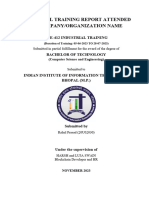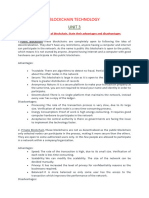Section1.
Deep Dive: How Cryptography Secures Blockchain Systems
Cryptography is like a secret code language that keeps information safe and secure. On a blockchain, it's used to make sure
that transactions are real, private, and can't be changed.
Public and Private Keys:
Lets imagine we have two special keys. One is a private key, which is like your secret diary key that only you have. The
other is a public key, which is like your mailing address that you can share with anyone. On a blockchain, your private key
lets you spend your digital money or prove you own something. Your public key is where people can send you digital
money or check your identity. For example, if someone wants to send you Bitcoin, they send it to your public key (your
Bitcoin address). To actually use that Bitcoin, you need your private key to "unlock" it.
Hashing:
Hashing is like taking any piece of information, no matter how big, and shrinking it down into a unique, fixed-size
fingerprint. This "fingerprint" is called a hash. Even if you change just one tiny thing in the original information, the hash
will be completely different. This makes it very easy to tell if someone has tampered with any data on the blockchain. For
instance, every block of transactions on a blockchain has a hash of the previous block. If someone tries to change an old
transaction, the hashes won't match up anymore, immediately showing that something is wrong.
Digital Signatures:
A digital signature is like a super secure handwritten signature, but for digital transactions. When you want to send money
on a blockchain, you "sign" the transaction using your private key. This signature is unique to that specific transaction and
to you. Anyone can then use your public key to verify that the signature is real and that the transaction truly came from you
and hasn't been changed.
Real-world Example:
Signing a transaction on Ethereum. When you use a digital wallet like MetaMask to send Ether (ETH), you're essentially
creating a message (the transaction) and then using your private key to put your "digital signature" on it. This signature
proves that you authorized the transfer. The Ethereum network then checks this signature using your public key. If the
signature is valid, the transaction is processed and added to the blockchain. This process ensures that only the rightful
owner of the private key can move funds from their address.
Section 2. Smart Contracts vs Traditional Agreements
By definition think of smart contracts as regular agreements, but super-powered and built into computer code on a
blockchain. Traditional agreements are usually written on paper, and you need lawyers or courts to make sure
everyone follows the rules. Smart contracts, however, automatically carry out their terms without anyone in the
middle.
Smart contracts work by having specific rules programmed into them. For example, on blockchains like Ethereum or
Celo, a smart contract could be set up for a simple agreement: "If Person A pays $100 to Person B, then the contract
automatically sends the digital item to Person A." Once the conditions are met, the contract executes by itself.
The main benefits of smart contracts include:
● Automation: They run automatically when conditions are met, so there's no waiting for people to
approve things.
● Transparency: Everyone can see the code of the smart contract on the blockchain, so there's no
hidden agenda.
● Cost Reduction: Since they don't need lawyers or other intermediaries, they can be much cheaper.
Real-world Examples:
Rental/Property Agreements (Tokenized Real Estate): Imagine renting an apartment. Traditionally, you sign a lease,
pay a deposit, and maybe a real estate agent helps. With smart contracts and "tokenized real estate," you could have a
digital representation of a property (a "token"). A smart contract could automatically send you a portion of the rent if
you own part of the token. Or, it could automatically transfer ownership of the digital token to a buyer once they've paid
the full amount, all without lots of paperwork or agents.
Crowdfunding (Gitcoin): When people raise money online (crowdfunding), a company usually holds the money and
gives it out when certain goals are met. This means you have to trust that company. With platforms like Gitcoin, smart
� contracts are used. People donate money to a smart contract, and the contract is programmed to automatically release
the money to the project when certain milestones are achieved and verified. This makes the whole process more
trustworthy and efficient.
Section 3. Research & Reflection
Layer 2s: Imagine a very popular highway (Layer 1 blockchain like Ethereum) that gets really crowded and
expensive to use because too many cars are on it. Layer 2s are like building smaller, faster side roads or
express lanes on top of that highway. They take some of the traffic (transactions) off the main highway,
process them quickly and cheaply, and then send a summary back to the main highway. This helps the main
highway breathe and become less congested. Platforms like Celo, Base, and Arbitrum are examples of
systems that help process more transactions at a lower cost, making blockchain more practical for everyday
use. Arbitrum, for instance, helps Ethereum handle many more transactions for much less money.
Testnets vs Mainnets: The mainnet is the "real" blockchain where actual digital money and valuable things
exist. It's where all the important transactions happen. A testnet, on the other hand, is like a practice version
of the mainnet. It looks and feels the same, but the digital money on it isn't real and has no value. Developers
use testnets like Goerli, Sepolia (for Ethereum), or Alfajores (for Celo) before launching their applications to
the mainnet. This is because testnets allow them to build, try out, and fix any problems with their smart
contracts and applications without risking anyone's real money. It's like rehearsing a play many times before
performing it live for an audience.























































































